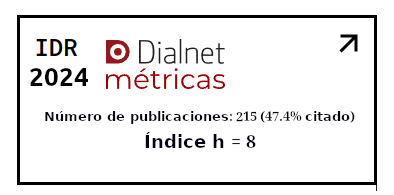Adaptation and validation of the RED-tecnoestrés scale in argentine university student population
Keywords:
Techno-stress; university students; conceptual and metric adaptationAbstract
The purpose of this study was to carry out an adaptation and validation of the RED-Technostress scale in a population of Argentinian students. A sample of 1956 university students with an average age of 24.69 (SD = 6.52, Min = 18, Max = 66) was used. 78.2% (n = 1295) were women, 21% (n = 433) were men, and 0.8% preferred not to indicate. In relation to the criteria established under expert judgment, adequate percentage values were obtained in the items, as well as Aiken V coefficients in all cases. The exploratory factor analysis explained 61.43% of the variance in the scores and determined the grouping of 22 items in 5 latent variables. The factorial solution yielded values deemed adequate, equal to .91 for the Kaiser Meyer Olkin index (KMO) and for the Bartlett Sphericity Test (χ² = 555.84; SD = 0.21; p <.000). The confirmatory factor analysis indicated a good fit of the five-factor model in the sample of Argentinian university students: χ2 = 4799.571., P <.000; CFI = .964; IFI = .954; RMSEA = .050 90% CI [.046, .054], p <.001. In addition, the regression coefficients for each element showed acceptable internal consistency indices for all sub-dimensions (fatigue, α ordinal = .93 and ω ordinal = .95; anxiety, α ordinal = .87 and ω ordinal = .90; α ordinal addiction = .76 and ω ordinal =. 84; and inefficiency α ordinal = .90 and ω ordinal = .91).
As a conclusion, the inventory is a valid and reliable instrument to evaluate techno-stress in the population of Argentinian university students.
Downloads
References
Aiken, L. R. (1985). Three coefficients for analyzing the reliability and validity of ratings. Educational and psychological measurement, 45(1), 131-142. https://doi.org/10.1177/0013164485451012
Bollen, K., y Long, J. (1993). Testing structural equation models. Sage.
Brod, C. (1984). Technostress: The human cost of the computer revolution. Reading, Mass. Addison-Wesley.
Brown, T. A. (2006). Confirmatory factor analysis for applied research. Guilford publications.
Browne, M. W., y Cudeck, R. (1993). Alternative ways of assessing model fit En: Bollen KA, Long JS, eds. Testing Structural Equation Models (pp. 136-162). Sage
Bruno, F. J. (1986). Dictionary of key words in psychology. Boston, MA: Routledge and Kegan.
Bryant, F. B., y Satorra, A. (2012). Principles and practice of scaled difference Chi-Square testing. Structural Equation Modeling: A Multidisciplinary Journal. 19, 372–398. https://doi.org/10.1080/10705511.2012.687671
Carlotto, M. S., y Câmara, S. G. (2012). Traducción, adaptación y explotación de las propiedades psicométricas de la escala de tecnoestrés-RED/TIC. Psicologia em Estudo, 15(1), 171-178. https://doi.org/10.1590/S1413-73722010000100018
Coulacoglou, C. y Saklofske, D. H. (2017). Psychometrics and psychological assessment principles and applications. Elsevier, Academic Press.
Epskamp, S., Stuber, S., Nak, J., Veenman, M., y Jorgensen, T. D. (2019). semPlot: Path Diagrams and Visual Analysis of Various SEM Packages’ Output (Version 1.1. 2). Computer software.
Escobar-Pérez, J., y Cuervo-Martínez, A. (2008). Validez de contenido y juicio de expertos: una aproximación a su utilización. Avances en medición, 6(1), 27-36. https://cutt.ly/FgwkzLH
Evans, J. D. (1996). Straightforward statistics for the behavioral sciences. Brooks/Cole Publishing.
Fletcher, T. D., y Fletcher, M. T. D. (2013). Package ‘psychometric’. Recuperado de http://cran.rproject. org/web/packages/psychometric/psychometric.pdfel,4
Freiberg Hoffmann, A., Stover, J. B., de la Iglesia, G. y Fernández Liporace, M. (2013). Correlaciones policóricas y tetracóricas en estudios exploratorios y confirmatorios. Ciencias Psicológicas, 7(2), 151-164. https://cutt.ly/agwkKzd
Hair, J. F., Black, W. C., Babin, B. J., Anderson, R. E., y Tatham, R. L. (2006). Multivariate data analysis. Pearson Prentice Hall.
Hu, L. T., Bentler, P. M., y Kano, Y. (1992). Can test statistics in covariance structure analysis be trusted?. Psychological bulletin, 112(2), 351. https://psycnet.apa.org/doi/10.1037/0033-2909.112.2.351
Hyrkäs, K., Appelqvist-Schmidlechner, K., y Oksa, L. (2003). Validating an instrument for clinical supervision using an expert panel. International Journal of nursing studies, 40(6), 619-625. https://doi.org/10.1016/S0020-7489(03)00036-1
Jiménez, A. L. (2010). Tecnología como fuente de estrés: una revisión teórica al concepto de tecnoestrés. Temas de Comunicación, (21), 157-180. https://cutt.ly/Bgwlqxs
Jorgensen, T. D., Pornprasertmanit, S., Schoemann, A. M., Rosseel, Y., Miller, P., Quick, C., y Garnier-Villarreal, M. (2018). semTools: Useful tools for structural equation modeling. R package version 0.5-1.
Kline, R. B. (2011). Principles and practice of structural equation modeling. Guilford Press.
Llorens, S., Salanova, M., y Ventura, M. (2011). Guía de intervención: Tecnoestrés. Síntesis.
Martorell, M. C., González, R., Odoñez, A., y Gómez, O. (2011). Estudio confirmatorio del cuestionario de conducta antisocial (CCA) y su relación con variables de personalidad y conducta antisocial. Revista Iberoamericana de Diagnóstico y Evaluación – e Avaliação Psicológica, 31(2), 35-52. https://cutt.ly/Ngwlj2A
McDonald, R.P. (1999). Test theory: A unified treatment. Erlbaum.
Muthén, B., y Kaplan, D. (1985). A comparison of some methodologies for the factor analysis of non‐normal Likert variables. British Journal of Mathematical and Statistical Psychology, 38(2), 171-189.
Nunnally, J. C., y Bernstein, I. H. (1994). Psychometric theory (3rd ed.). McGraw Hill.
Pérez-Gil, J. A., Moscoso, S. C., y Rodríguez, R. M. (2000). Validez de constructo: el uso de análisis factorial exploratorio-confirmatorio para obtener evidencias de validez. Psicothema, 12(Suplemento), 442-446. https://cutt.ly/PgwlmPb
Revelle, W. (2018a). Psych: Procedures for personality and psychological research (Version 1.9. 12.31). Computer software. Northwestern University.
Revelle, W. (2018b). Psycho: Procedures for personality and psychological research (Version 1.9. 12.31). Computer software. Northwestern University.
Rosseel, Y. (2012). Lavaan: An R package for structural equation modeling and more Version 0.5–12 (BETA). Journal of statistical software, 48(2), 1-36. https://cutt.ly/xgwlRZJ
Salanova, M., Llorens, S., Cifre, E., y Nogareda, C. (2007). Tecnoestrés: concepto, medida e intervención psicosocial. Nota técnica de prevención, 730, (21 serie). Madrid: Instituto Nacional de Seguridad e Higiene en el Trabajo.
Schaufeli, W., y Bakker, A. (2003). Utrecht work engagement scale. Utrecht University.
Schumacker, R., y Lomax, R. (2016). A beginner´s guide to structural equation modeling. Routledge.
Tinsley, H. E., y Weiss, D. J. (1975). Interrater reliability and agreement of subjective judgments. Journal of Counseling Psychology, 22(4), 358. https://doi.org/10.1037/h0076640
Tornimbeni, S., Pérez, E., Olaz, F., de Kohan, N. C., Fernández, A., y Cupani, M. (2008). Introducción a la psicometría. Paidós.
Wang, K., Shu, Q., y Tu, Q. (2008). Technostress under different organizational environments: An empirical investigation. Computers in Human Behavior, 24(6), 3002-3013. https://doi.org/10.1016/j.chb.2008.05.007
Weil, M.M. y Rosen, L.D. (1997). Technostress: Coping with technology @work, @home, @play. John Wiley and Sons.
Wickham, H. (2009). Elegant graphics for data analysis (ggplot2). Springer.
Published
How to Cite
Issue
Section
License
Copyright (c) 2021 ACADEMO Revista de Investigación en Ciencias Sociales y Humanidades

This work is licensed under a Creative Commons Attribution 4.0 International License.








